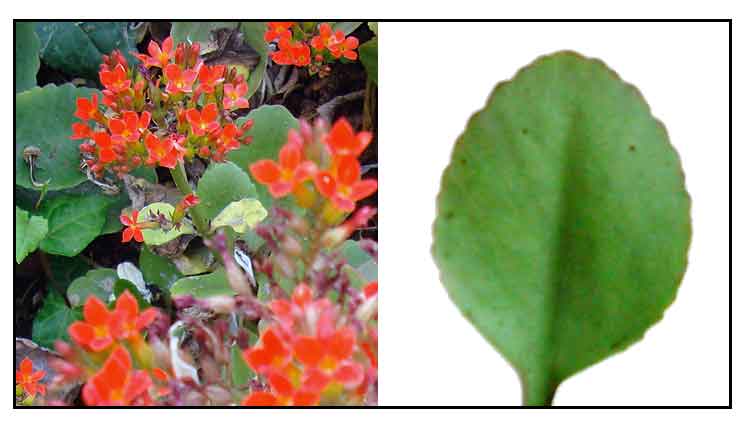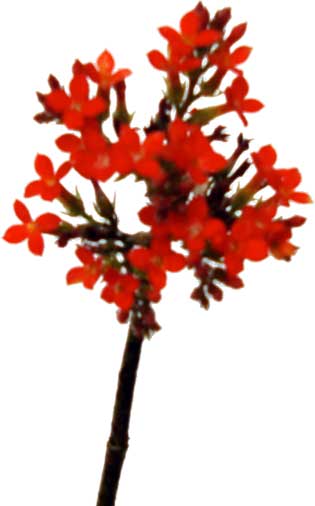| 
 Gen info Gen info
- Kalanchoe blossfeldiana is a herbaceous and commonly cultivated house plant in the genus Kalanchoe and family Crassulaceae.
- Etymology: Its etymological roots vary. The genus name Kalanchoe derives from 'Kalanchauhuy', a Chinese name for one species recorded by Georg Josepjh Kamel, a botanist and Jesuit missionary to the Philippines. The Oxford dictionary suggests it is based on the Chinese 'galancai', while Collins English Dictionary suggests it was derived from a local Chinese name for one of the species. The specific epithet blossfeldiana honors the German hybridiser and botanist Robert Blossfed, who introduced the plant to the world in 1932. (12)
- Probably the most popular and widely cultivated of the Kalanchoe species.
Botany
Kalanchoe is a succulent, compact herb, growing to a height of 30 to 45 centimeters. Leaves
are opposite, obovate, fleshy, sessile, glossy-green, 5 to 10 centimeters long, with slightly crenate
or entire margins. Leaf veins are absent or indistinct. Inflorescences are terminal, borne by peduncles higher than the foliage.
Flowers are many, red and small, with four petals, grouped in flower heads, borne on long stems, each head having between 20 to 50 flowers.
Distribution
- Introduced.
-
Common garden plant.
- Ornamental cultivation.
- Native to Madagascar.
 Constituents Constituents
• Study shows citronellol
and geraniol can be obtained from KB.
• Study yielded flavonoids in flowers of 16 Kalanchoe blossfeldiana
varieties.
• Phytochemical screening of methanol and water extracts yielded alkaloids, glycosides, flavonoids, tannin, saponin, resin and phenols.
• Methanol extract of leaves yielded (1) neophytadiene; (2) palmitic acid; (3) phytol; (4) dihomo-gamma-linoleic acid (DGLA); (5) stearic acid; (6) delta- Tocopherol; (7) beta- Tocopherol; (8) gamma- Tocopherol; (9) vitamin E; (10) dihydrobrassicasterol; (11) γ- sitosterol; (12) lupenyl acetate; (13) friedeland; (14) Trilinolein.
(see study below) (9)
• Study of methanol extract of leaves for phenolic compounds yielded 3,3',4',5,7 pentahydroksi flavonorquercetin (1), epigallocatechingallate (2), and gallic acid (3). (15)
- Phytochemical screening of acetone (A), aqueous (Aq), and methanol (M) extracts yielded tannins (A,Aq,M), flavonoids (A,Aq,M), saponins (A,M), carbohydrate (M), cardiac glycosides (Aq), phenols (A,Aq,M), quinones (A), terpenoids (A,Aq,M) and alkaloids (A,Aq,M). Total flavonoid
content was 1250 µg/ml and phenolic content
of 600 µg/ml.
Properties
• Considered antiviral, antiseptic, disinfectant.
• Poisoning: Report on cattle poisoning attributed to K. blossfeldiana. (see study below) (17)
•
Studies have shown antiviral, antimicrobial, antiplasmodial, antioxidant, air-purifying, cytotoxicity, anticancer properties.
Uses
Folkloric
- No reported folkloric
medicinal use in the Philippines.
Studies
• Anthocyanin: Methyl jasmonate stimulates the formation and the accumulation
of anthocyanin in Kalanchoe blossfeldiana.
• Antiviral: Antiviral activity of
representatives of the family Crassulaceae: A
study of antiviral properties of the juice of 11 species of the orpine
family, 8 of them belonging to the genera Kalanchoe, showed a high virus
neutralizing activity of the juice from 4 Kalanchoe species, including
K. blossfeldiana. (3)
• Flavonoids in Flowers: K blossfeldiana varieties with orange, pink, red and magenta flowers yielded 3,5-O-B-D-diglucosides of pelargonidin, cyanidin, peonidin, delphinidin, petunidin and malvidin. Pink, red and magenta varieties had relatively high amounts of quercetin based flavonols. (2)
• Antiplasmid Potential Against MDR Pseudomonas aeruginosa: Methanolic and aqueous crude extracts of Kalanchoe blossfeldiana were used as medicinal plant for curing agent for reduction of antibiotic resistance genes of P. aeruginosa isolate P9. The effect of MIC of methanolic extract caused a reduction of resistance from 44-100% white the aqueous extract revealed decreasing of resistance from 36-86%. (5)
• Antimicrobial / Quorum Sensing-Mediated Bacterial Biofilm Formation: Study investigated the antimicrobial properties of K. blossfeldiana with particular reference to quorum sensing (QS)- mediated biofilm formation. Methanol extract of KB reduced the secretion of virulence factors (protease and pyoverdin). Results showed KB interefered with AHL production which may be responsible for down-regulating QS-mediated production of biofilm and virulence. (7)
• Air-Purifying Property / Benzene: In a study of six plants evaluating their ability to remove benzene, trichloroethylene (TCE) and toluene from the air, Kalanchoe blossfeldiana appeared to take up benzene selectively over toluene. (8)
• Antioxidant / Leaves: Study evaluated the antioxidant potential of plant leaf extracts of Kalanchoe blossfeldiana by DPPH and FRAP assays. Methanol and ethanol extracts yielded total phenols (39.99±1.52 and 63.21±0.62 µg gallic acid equivalents/mg extract) and flavonoids (6.47±0.16 & 6.64±0.15 µg quercetin/mg extract), respectively. (9)
• Antiplasmodial / Leaves: Study evaluated various extracts of leaves for antiplasmodial activity against Plasmodium falcifarum. Study isolated a phenolic compound, namely 3,3',4',5,7-pentahydroxyflavone or quercetin (1), and displayed antiplasmodial activity with IC50 3.97x10-2 nM. (10)
• Cytotoxicity / Antimicrobial / Leaves: Study evaluated the cytotoxic and antimicrobial activities of fresh leaves of Kalanchoe blossfeldiana, K. daigremontiana, and K. pinnata. K. blossfeldiana ethanol extract and K. daigremontiana water extract exhibited most potent cytotoxic activity (IC50 <19 µg/mL for HeLa and SKOV-3 cells. Ethanol extract of K. blossfeldiana and K. pinnata showed strongest antibacterial effects with MIC values of 8.45, 8.45, 0.25, and <33.75 µg/mL for S. aureus, S. epidermis, and E. hirae, respectively. Results suggest K. blossfeldiana extract is a potential candidate for cancer and antibacterial infection treatment. (13)
• Anticancer / Human Cervical Carcinoma (HeLa) Cells / Leaves: Study evaluated the cytotoxic activity of K. blossfeldiana leaves on human cervical carcinoma (HeLa) cells and its mode of cell death. The KB extract showed IC50 values of 8.28 and 9.63 in RTCA and MTT assay, respectively. There was a significant increase in generation of ROS and depolarization of mitochondria in the dead cell population. The extract also induced cell cycle arrest in S phase. Results suggest KB extract induces necrosis in HeLa cells, a process that is death receptor-mediated, which leads to overproduction of ROS, mitochondrial dysfunction, and cell cycle arrest. (14)
• Outbreak of Poisoning in Cattle: Primarily plant as an ornamental and houseplant, in some countries Kalanchoe species have escape cultivation and can be found in the field. Study reports on an outbreak of poisoning by Kalanchoe blossfeldiana i cattle in the semiarid region of Pernambuco, Brazil. Plant prunings were disposed of in a pasture with shortage of forage. Seventeen cattle had clinical signs of poisoning, and thirteen died 4-5 days after onset of clinical signs. The signs, gross and histological lesions include gastrointestinal, cardiovascular, and neuromuscular involvement. Kalanchoe spp. contain cardiotoxic glycosides, and the signs and lesions in the cattle were consistent with toxin poisoning from plants. (17)
Availability
- Ornamental garden cultivation. |


![]()

